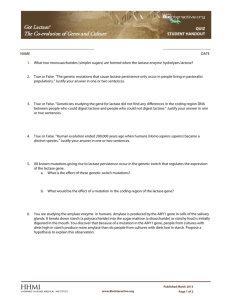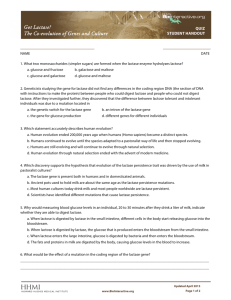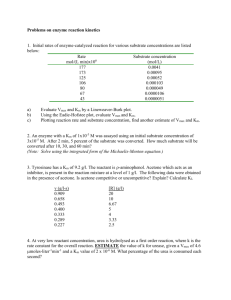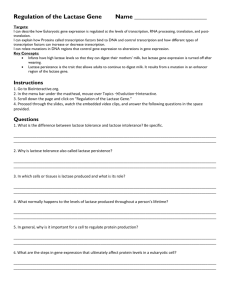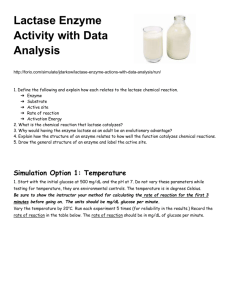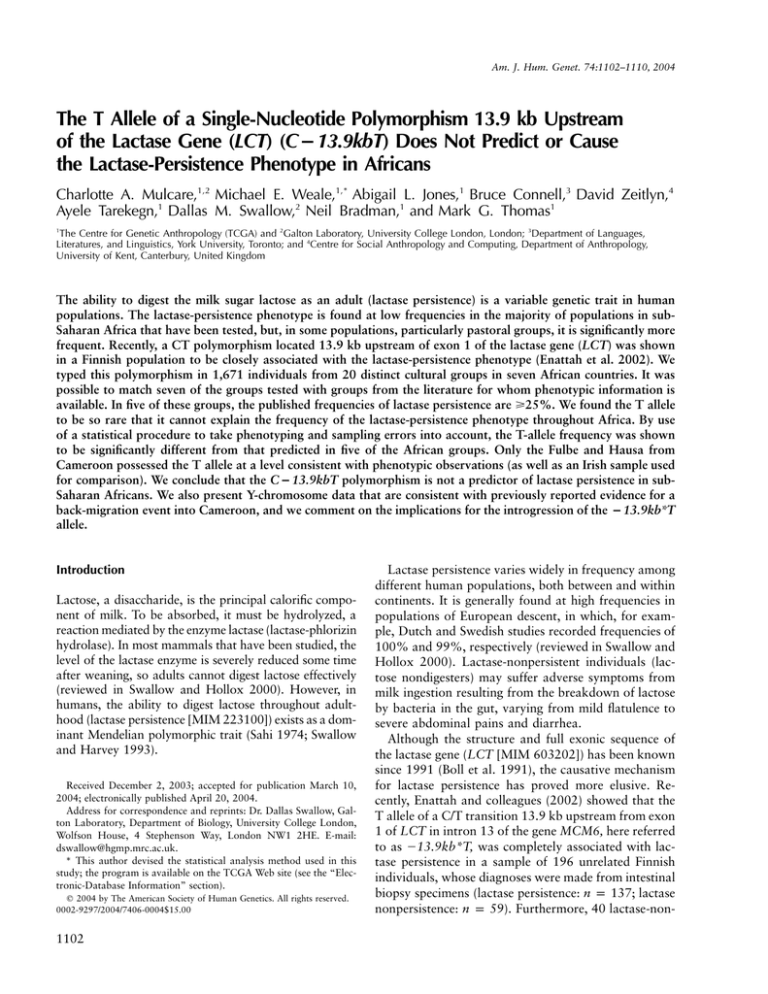
Am. J. Hum. Genet. 74:1102–1110, 2004
The T Allele of a Single-Nucleotide Polymorphism 13.9 kb Upstream
of the Lactase Gene (LCT) (C513.9kbT) Does Not Predict or Cause
the Lactase-Persistence Phenotype in Africans
Charlotte A. Mulcare,1,2 Michael E. Weale,1,* Abigail L. Jones,1 Bruce Connell,3 David Zeitlyn,4
Ayele Tarekegn,1 Dallas M. Swallow,2 Neil Bradman,1 and Mark G. Thomas1
1
The Centre for Genetic Anthropology (TCGA) and 2Galton Laboratory, University College London, London; 3Department of Languages,
Literatures, and Linguistics, York University, Toronto; and 4Centre for Social Anthropology and Computing, Department of Anthropology,
University of Kent, Canterbury, United Kingdom
The ability to digest the milk sugar lactose as an adult (lactase persistence) is a variable genetic trait in human
populations. The lactase-persistence phenotype is found at low frequencies in the majority of populations in subSaharan Africa that have been tested, but, in some populations, particularly pastoral groups, it is significantly more
frequent. Recently, a CT polymorphism located 13.9 kb upstream of exon 1 of the lactase gene (LCT) was shown
in a Finnish population to be closely associated with the lactase-persistence phenotype (Enattah et al. 2002). We
typed this polymorphism in 1,671 individuals from 20 distinct cultural groups in seven African countries. It was
possible to match seven of the groups tested with groups from the literature for whom phenotypic information is
available. In five of these groups, the published frequencies of lactase persistence are ⭓25%. We found the T allele
to be so rare that it cannot explain the frequency of the lactase-persistence phenotype throughout Africa. By use
of a statistical procedure to take phenotyping and sampling errors into account, the T-allele frequency was shown
to be significantly different from that predicted in five of the African groups. Only the Fulbe and Hausa from
Cameroon possessed the T allele at a level consistent with phenotypic observations (as well as an Irish sample used
for comparison). We conclude that the C513.9kbT polymorphism is not a predictor of lactase persistence in subSaharan Africans. We also present Y-chromosome data that are consistent with previously reported evidence for a
back-migration event into Cameroon, and we comment on the implications for the introgression of the 513.9kb*T
allele.
Introduction
Lactose, a disaccharide, is the principal calorific component of milk. To be absorbed, it must be hydrolyzed, a
reaction mediated by the enzyme lactase (lactase-phlorizin
hydrolase). In most mammals that have been studied, the
level of the lactase enzyme is severely reduced some time
after weaning, so adults cannot digest lactose effectively
(reviewed in Swallow and Hollox 2000). However, in
humans, the ability to digest lactose throughout adulthood (lactase persistence [MIM 223100]) exists as a dominant Mendelian polymorphic trait (Sahi 1974; Swallow
and Harvey 1993).
Received December 2, 2003; accepted for publication March 10,
2004; electronically published April 20, 2004.
Address for correspondence and reprints: Dr. Dallas Swallow, Galton Laboratory, Department of Biology, University College London,
Wolfson House, 4 Stephenson Way, London NW1 2HE. E-mail:
dswallow@hgmp.mrc.ac.uk.
* This author devised the statistical analysis method used in this
study; the program is available on the TCGA Web site (see the “Electronic-Database Information” section).
䉷 2004 by The American Society of Human Genetics. All rights reserved.
0002-9297/2004/7406-0004$15.00
1102
Lactase persistence varies widely in frequency among
different human populations, both between and within
continents. It is generally found at high frequencies in
populations of European descent, in which, for example, Dutch and Swedish studies recorded frequencies of
100% and 99%, respectively (reviewed in Swallow and
Hollox 2000). Lactase-nonpersistent individuals (lactose nondigesters) may suffer adverse symptoms from
milk ingestion resulting from the breakdown of lactose
by bacteria in the gut, varying from mild flatulence to
severe abdominal pains and diarrhea.
Although the structure and full exonic sequence of
the lactase gene (LCT [MIM 603202]) has been known
since 1991 (Boll et al. 1991), the causative mechanism
for lactase persistence has proved more elusive. Recently, Enattah and colleagues (2002) showed that the
T allele of a C/T transition 13.9 kb upstream from exon
1 of LCT in intron 13 of the gene MCM6, here referred
to as ⫺13.9kb*T, was completely associated with lactase persistence in a sample of 196 unrelated Finnish
individuals, whose diagnoses were made from intestinal
biopsy specimens (lactase persistence: n p 137; lactase
nonpersistence: n p 59). Furthermore, 40 lactase-non-
1103
Mulcare et al.: Lactase Polymorphism in Africa
persistent individuals from various populations (Germany, Italy, South Korea) were all homozygous for the
C allele. Finally, DNA from individuals of unknown
phenotype collected in Finland (n p 938), France (n p
17), and the United States (two data sets: African descent [n p 96] and European descent [n p 92]) had
frequencies of the CC genotype that appeared to be
consistent with the frequencies of lactase nonpersistence
reported for those groups. Although no functional
mechanism was shown at that time, presence of
⫺13.9kb*T was proposed as a robust marker for lactase
persistence. Very recent studies have suggested that this
SNP is located in an enhancer element and that the two
alleles show some difference in function (Olds and Sibley 2003; Troelsen et al. 2003). C⫺13.9kbT typing is
now being offered as a genetic test for lactase persistence
in Finland (Medix Laboratory), where the strong correlation between the T allele and lactase persistence was
first reported, and such testing is being considered for
use elsewhere (Buning et al. 2003; Hoegenauer et al.
2003).
To date, there have been no reports of allele frequencies for the C⫺13.9kbT polymorphism in populations living in Africa. Although the ⫺13.9kb*T allele
frequency in Americans with African ancestry is consistent with their lactase-persistence frequency (Enattah
et al. 2002), there is known to be substantial admixture
between African Americans and European Americans
(Parra et al. 1998). Previous studies of African populations showed variation in the frequency of lactase persistence among population groups, as well as a complex
pattern of distribution (reviewed in Flatz 1987; Holden
and Mace 1997; Swallow and Hollox 2000). Pastoralists, such as the Fulbe in Nigeria, typically have higher
frequencies of lactase persistence than nonpastoralists
in the same country—for example, the Yoruba and Igbo
(Kretchmer et al. 1971; Olatunbosun and Adadevoh
1971; Ransome-Kuti et al. 1972, 1975; Flatz 1987; Holden and Mace 1997). The lactase-persistence phenotype
is usually observed at low frequencies in Bantu- and
Khoisan-speaking groups (!20%) (Cook and Kajubi
1966; Cook et al. 1967, 1973; Cox and Elliott 1974;
Nurse and Jenkins 1974; O’Keefe and Adam 1983; Segal et al. 1983; O’Keefe et al. 1984).
We have typed C⫺13.9kbT in 1,671 individuals from
20 different African populations, including both milkdrinking and non–milk-drinking groups. Since phenotype
data was not available for these samples, we performed
an ethnologically matched group study to determine
whether ⫺13.9kb*T was associated with lactase persistence in seven African samples and in one northern European sample (to provide a comparative group), using
a statistical procedure to take both sampling and phenotyping error into account. We show that, in most cases
in Africa, the frequency of ⫺13.9kb*T is too low to
explain the observed frequency of lactase persistence.
Material and Methods
Samples
DNA was extracted from buccal swabs collected from
males belonging to different groups living in various
regions of Africa, including populations that have a history of pastoralism and milk drinking and others that
do not (table 1). DNA was also obtained from a sample
of unrelated Irish individuals for comparative purposes.
Informed consent was obtained from all donors. Ethical
approval was obtained from University College Hospitals and University College London Joint Committee on
the Ethics of Human Research (reference number 99/
0196). Appropriate permissions were obtained in each
of the collection countries (reference number for Cameroon 0093MINREST/B00/D00/D10/D12). Each donor
provided biographical details, such as self-defined ethnic
identity, first and second language, and place of birth,
with similar information on his mother, father, maternal
grandmother, and paternal grandfather. Individuals were
classified as belonging to a given cultural group if their
own self-declared identity concurred with that they ascribed to both mother and father. Where there were !10
individuals of the same declared cultural identity, they
were classified as “other.” Individuals with partially unknown or mixed ancestry at the parental level were also
classified as “other.” The Ethnographic Atlas (Murdock
1967) and a summary table of pastoralists (Blench 1999)
were used to obtain information about pastoralism and
milk practice, and the Ethnologue Web site was used to
check possible linguistic relationships between groups.
Selection of Matched Populations for Which
Phenotypic Data Were Available
For many of the population groups, a matching population sample with lactose-tolerance (digestion) data
could be found in the literature. Matching samples were
selected to fulfill the following criteria: (1) same declared
cultural identity and (2) residency in the same country
or in a neighboring country. Sources for data on lactase
persistence are listed in table 2.
Typing the C⫺13.9kbT Polymorphism
PCR primers LAC-C-M-U (5-GCTGGCAATACAGATAAGATAATGGA-3) and LAC-C-L2 (5-CTGCTTTGGTTGAAGCGAAGAT-3) were designed to amplify
the region containing the C/T polymorphism (Enattah
et al. 2002). The penultimate base of the LAC-C-M-U
primer (G) introduces a base change such that the PCR
product will be cut by HinfI when the T allele is present,
giving digestion product sizes of 177 bp and 24 bp, but
1104
not when the C allele is present, giving a digestion product size of 201 bp. PCR reactions were performed in a
total volume of 10 ml containing 200 mM dNTPs, 10
mM Tris-HCl (pH 9.0), 0.1% Triton X-100, 0.01% gelatin, 50 mM KCl, 2.0 mM MgCl2, 0.13 U Taq polymerase enzyme (HT Biotech), 9.3 nM TaqStart monoclonal antibody (BD Biosciences, Clontech), and 0.3 mM
primers. The Taq and TaqStart monoclonal antibodies
were premixed prior to being added to the other reagents. Thermal cycling conditions were an initial denaturation stage at 95⬚C for 5 min, then 35 cycles of
95⬚C for 1 min, 59⬚C for 1 min, and 72⬚C for 1 min,
followed by a final elongation stage at 72⬚C for 5 min.
Digestions were performed at 37⬚C overnight in the original PCR plate in a total volume of 25 ml. Each reaction
contained the entire PCR product, 0.25 U of HinfI, 0.01
mg/ml acetylated BSA, and New England Biolabs Buffer
2, as recommended by the manufacturer. The digestion
products were run on a 3% agarose gel, and DNA bands
were visualized by use of ethidium bromide staining. Gel
phenotypes showing a single band of 201 bp (C) or 177
bp (T) were interpreted as genotypes ⫺13.9kb*CC and
⫺13.9kb*TT, respectively.
Genotype Error Checking
One positive control (a known CT heterozygote) and
a blank were included in every 96-well plate. In addition,
a set of 50 randomly selected samples were retyped
“blind.” All controls and the 50 retyped samples matched
the initial typing. As a further control that the results for
the SNP matched those reported by Enattah et al. (2002),
our SNP protocol was used for typing phenotyped Finnish
individuals. There was a high, although incomplete, correlation between the T allele and lactose-tolerance test
results (Poulter et al. 2003). The level of discrepancy was
attributable to inaccuracies of the tolerance testing and
was consistent with the error rates we use in our statistical
procedure described below.
Statistical Analysis
Our genotype-error–checking procedure (see above)
suggested that the genotyping error rate was zero or
negligible. However, phenotyping error in the determination of lactose digestion as an indirect test for lactasepersistence status (e.g., by measurement of breath hydrogen or blood glucose) is known to occur at
appreciable levels. It is the convention in the medical
literature to describe lactose digesters as “negative” and
nondigesters as “positive”—that is, giving a positive diagnosis in a lactose-tolerance test. We obtained information on the error rates of false-negative (FN) results
(i.e., when a nonpersistent person appears to be a digester) and false-positive (FP) results (i.e., when a persistent person appears to be a nondigester) from three
Am. J. Hum. Genet. 74:1102–1110, 2004
studies in which the correct lactase phenotype was ascertained by peroral jejunal biopsy and from two studies
in which the “correct” phenotype was determined by
the “gold standard” method. When the “gold standard”
method is used, at least two of three separate noninvasive tests (namely, blood glucose, breath hydrogen,
and urine galactose) must concur. Error rates for the
three studies ascertained by biopsy were as follows (sample sizes in the denominator): (1) blood glucose FN p
6/25 and FP p 1/25, breath hydrogen FN p 0/25 and
FP p 0/25 (Newcomer et al. 1975); (2) blood glucose
FN p 0/7 and FP p 0/8, breath hydrogen FN p 0/7
and FP p 0/8 (Howell et al. 1981); and (3) blood glucose
not measured, breath hydrogen FN p 5/16 and FP p
2/47 (Arola et al. 1988). Error rates for the two studies
ascertained by the “gold standard” method were as follows (sample sizes in the denominator): (1) blood glucose
FN p 3/35 and FP p 3/35, breath hydrogen FN p 2/
35 and FP p 2/35 (Puehkuri 2000); and (2) blood glucose FN p 1/49 and FP p 1/5, breath hydrogen FN p
2/49 and FP p 1/5 (Kurt et al. 2003). Exact protocols
for the blood glucose and breath hydrogen tests varied
among the five studies, as they did among the studies
on matching populations reported later. However, all
protocols involved the measurement of changes in
plasma glucose or exhaled hydrogen at one or more time
intervals between 30 min and 4 h after administration
of at least 50 g lactose. We combined the results from
the above five studies to perform a rough averaging over
the differences in protocols used (blood glucose FN p
10/116 and FP p 5/73, breath hydrogen FN p 9/132
and FP p 5/120). The combined results suggest that,
even if a population has no lactase-persistent individuals,
we would expect, by use of one of these two methods,
to find between 5% and 10% FNs (i.e., apparent lactose
digesters).
Given the above and assuming that the underlying
phenotyping error rates acting in these independent studies are applicable to other studies that use the same measurement techniques, we devised a statistical procedure
that allowed us to test whether the frequency of lactose
digesters predicted by the C⫺13.9kbT genotype data
was sufficient to explain the observed frequency found
in the phenotyped group. We took both phenotyping
error and four possible sources of sampling uncertainty
into account: (1) sampling uncertainty in p, the frequency of the ⫺13.9kb*T in the genotyped group; (2)
sampling uncertainty in fn, the frequency of false negatives according to the phenotyping method used; (3)
sampling uncertainty in fp, the frequency of false positives according to the phenotyping method used; and (4)
sampling uncertainty in Lapp, the frequency of apparent
lactase persistence in the phenotyped group.
The procedure was performed as follows:
1. A value for p was drawn from a Beta(T⫹1, C⫹1)
1105
Mulcare et al.: Lactase Polymorphism in Africa
Table 1
Published Information on Pastoralism and the Observed Frequency of 513.9kb*T, by Population Group
OBSERVED
FREQUENCY
NO. OF
INDIVIDUALS
NO. OF
INDIVIDUALS
WITH GENOTYPE
CC
CT
TT
⫺13.9kb*T
46–55% (Yes)
16–35% (No)
NA
16–25% (No)
6–15% (No)
NA
NA
49
18
70
122
126
21
128
39
14
70
121
126
21
118
9
3
0
1
0
0
9
1
1
0
0
0
0
1
.112
.139
0
.004
0
0
.043
No
No
No
6–15% (No)
6–15% (No)i
NA
110
44
22
110
44
22
0
0
0
0
0
0
0
0
0
No
No
No
No
No
6–15% (Yes)
6–15% (Yes)
6–15% (No)
6–15%
NA
84
14
58
49
58
84
14
58
49
58
0
0
0
0
0
0
0
0
0
0
0
0
0
0
0
No
No
NA
26–35% (Yes)
NA
NA
69
93
19
69
93
18
0
0
1
0
0
0
0
0
.026
No
No
Mixed
NA
NA
NA
30
11
88
30
11
88
0
0
0
0
0
0
0
0
0
Yes
Yes
Mixed
46–55% (Yes)
46–55% (Yes)
NA
34
13
73
34
13
73
0
0
0
0
0
0
0
0
0
Yes
Yesh
NA
46–55% (Yes)
6–15% (Yes)
NA
119
108
1
119
108
1
0
0
0
0
0
0
0
0
0
No
No
NA
NA
NA
36–45% (Yes)
22
18
47
22
18
1
0
0
10
0
0
36
0
0
.872
PASTORALISTa
STATUS
% DEPENDENT
ON ANIMAL
HUSBANDRY
(MILKING STATUS)b
Yes
No
No
No
No
No
NA
NOMADIC
COUNTRY
GROUP
AND
Cameroon:
Fulbec
Hausad
Kwanjae
Mambilae
Nsoe (Nsaw)
Yambae
Other
Nigeria:
Ibibio
Oron
Other
Malawi:
Chewae
Ngonie
Tumbukae
Yaoe
Othere
Senegal:
Woloff
Manjak
Other
Sudan (North):
Ga’ali
Shaigi
Otherg
Sudan (South):
Dinka
Nuer
Otherg
Ethiopia:
Nuer
Anuak (Anywak)
Other
Uganda:
Mussessee
Othere
Ireland
OF
NOTE.—NA p not available.
a
Pastoralists who migrate with their animals. From table 2.1 in Blench (1999).
b
Murdock (1967).
c
Fulbe with a sedentary lifestyle.
d
Immigrant population from Nigeria.
e
Bantoid-language speakers.
f
Includes 23 “Lebou” individuals. Lebou is a dialect of Wolof.
g
This group includes 12 individuals from traditional milk-drinking peoples of known high frequency for
lactase persistence (Beja, Misseri, Gomoeia, and Shilluk [Bayoumi et al. 1981, 1982]).
h
Probably do not drink fresh milk (A. Tarekegn, unpublished data).
i
Identical to Ibibio in this respect.
distribution, where T is the number of T alleles and
C is the number of C alleles found in the genotyped
group. This beta distribution describes the posterior
distribution for p, given the genotype data, assuming a Uniform(0,1) prior.
2. The predicted frequency of true lactase persistence
in the population, Ltrue , was calculated as
p2⫹2p(1⫺p) (i.e., the expected frequency of TT ⫹
CT genotypes under Hardy-Weinberg equilibrium).
3. Values for fn and fp were drawn from Beta(11,107)
Table 2
Comparisons with Published Lactose-Digester Frequencies in Matching Populations, Taking into Account Sampling and Phenotyping Error
Group
Fulbea
Hausa
Wolof
Ga’ali (Jaali)
Shaigi
Nuer
Dinka
European
Country of Genotyped Sample
(No.)
Cameroon (n p 49)
Cameroon (n p 18)
Senegal (n p 69)
Sudan (North) (n p 30)
Sudan (North) (n p 11)
Sudan (South), Ethiopia (n p 132)
Sudan (South) (n p 34)
Ireland (n p 47)
Country of
Expected Frequency of Phenotyped Sample
Lactose Digesters
(No.)
.265
.305
.086
.068
.068
.068
.068
.918
Nigeria (n p 24)
Nigeria (n p 17)
Senegal (n p 53)
Sudan (n p 113)
Sudan (n p 42)
Sudan (n p 23)
Sudan (n p 208)
Ireland (n p 50)
Test Method
Blood glucose
Blood glucose
Blood glucose
Breath hydrogen
Breath hydrogen
Breath hydrogen
Breath hydrogen
Blood glucose
Observed Frequency of
Lactose Digesters in
Phenotyped Sample
Reference
P Value
.292
.235
.509
.531
.381
.217
.255
.900
Kretchmer et al. 1971
Kretchmer et al. 1971
Arnold et al. 1980
Bayoumi et al. 1981
Bayoumi et al. 1981
Bayoumi et al. 1982
Bayoumi et al. 1982
Fielding et al. 1981b
1
.749
0
0
.025
.030
.001
1
NOTE.—Expected frequency of lactose digesters, taking into account the test error rate by the method used in the matched population p Ltrue(1⫺fp) ⫹ (1⫺Ltrue)fn, where
Ltrue p frequency of CT ⫹ TT genotypes assuming Hardy-Weinberg equilibrium, (fn,fp) p (10/116, 5/73) if the blood glucose test method is used and (fn,fp) p (9/132, 5/120)
if the breath hydrogen test method is used. P value p result of test described in the “Statistical Analysis” section.
a
Fulbe with a sedentary lifestyle.
b
Blood glucose results only taken from this source, by use of a rise of 120 mg/dl to define lactose digester.
1107
Mulcare et al.: Lactase Polymorphism in Africa
and Beta(6,69) distributions, respectively, if phenotyping was by the blood glucose method and
from Beta(10,124) and Beta(6,116) distributions,
respectively, if phenotyping was by the breath hydrogen method. Again, these beta distributions describe the posterior distribution for fn and fp, given
the combined false error rate data reported above
and assuming a Uniform(0,1) prior.
4. The predicted frequency of apparent lactose digesters accounting for phenotyping error, Lapp, was
calculated as Ltrue(1⫺fp) ⫹ (1⫺Ltrue)fn.
5. A simulated value for nL, the number of lactose
digesters observed in the phenotyped group was
drawn from a Binomial(n,Lapp) distribution, where
n is the number sampled in the phenotyped group.
6. Steps 1–5 were repeated 100,000 times (N p
100,000) to build up a Monte Carlo sampling distribution for nL under the null hypothesis that the
C/T genotype and phenotyping error alone account
for the apparent frequency of lactose digesters.
7. Let Sg be the sum of simulated nL values greater
than or equal to the observed nL value, and let Sl
be the sum of simulated nL values less than or equal
to the observed nL value. A two-tailed P value for
the observed nL under the null hypothesis was
found as 2 # min(Sg,Sl)/N.
Y-Chromosome Haplotypes
Cruciani and colleagues (2002) reported the presence
of a non-African Y-chromosome lineage (M173-derived
haplotype 117, or R1*, by use of nomenclature of the
Y-Chromosome Consortium [2002]) in population
groups from northern Cameroon. These authors suggested this was due to a back-migration event from outside sub-Saharan Africa. We typed our samples for a
genealogically similar marker, 92R7 (Mathias et al.
1994), which is ancestral to M173 but for which intermediate haplotypes (92R7-derived, M173-ancestral)
have not been reported in any study of sub-Saharan African populations to date. We also typed 92R7-derived
samples for six Y-chromosome microsatellites (DYS19,
DYS388, DYS390, DYS391, DYS392, and DYS393) to
investigate the intrahaplogroup diversity. Protocols for
the typing of 92R7 and the microsatellites are those described by Thomas et al. (1999). Microsatellite repeat
numbers were assigned according to the nomenclature
of Kayser and colleagues (1997). Genetic diversity, h,
and its SE were calculated according to the unbiased
formulae in the work of Nei (1987). Since Y-chromosome typing was not successful in 72 of the 1,671 samples, we also report separately the different Y-chromosome sample sizes.
Results
C⫺13.9kbT in Africa
The frequency of ⫺13.9kb*T was low or zero in most
of the African groups tested, whereas it was very high
in the Irish sample (table 1). In the African populations,
the ⫺13.9kb*T allele was only found in a few individuals; all but one of these individuals were from Cameroon and lived close to the same market town, Mayo
Darle. Of these individuals, there were 10 Fulbe, 4
Hausa, 1 Mambila, and 10 “others” (mixed ancestry or
from other ethnic groups). In all but two cases (one
Hausa and one “other” individual), the ⫺13.9kb*T-carrying individuals or one or both of their parents spoke
Fulfulde, a Fulbe language. This association between
possession of the ⫺13.9kb*T allele and speaking Fulfulde was significant both in the Cameroonian sample
as a whole (P ! .001, n p 534, Fisher’s exact test) and
in the non-Fulbe Cameroonians (P p .015, n p 485,
Fisher’s exact test). The one individual from Senegal carrying ⫺13.9kb*T allele was of mixed Wolof and Toucouleur (Tukulor) ancestry. There were no significant
departures from Hardy-Weinberg equilibrium in any of
the ascribed ethnic groups where T alleles were observed
(by use of the method of Guo and Thompson [1992]).
It is noteworthy that ⫺13.9kb*T was not found in
East Africa at all, even though the data sets included
many known pastoralists and groups with a high frequency of lactase persistence (table 1).
Matched Populations for Which Phenotypic Data Were
Available
In some cases, it was possible to find closely matching
populations in the literature that had phenotype information (table 2). Comparisons of the predicted frequencies of lactase persistence, deduced from the frequency of ⫺13.9kb*TT and ⫺13.9kb*CT genotypes,
with the reported frequencies obtained from lactose-tolerance testing, showed these were significantly different
in all of the African populations except the Fulbe and
the Hausa. Only in these two Cameroonian groups was
⫺13.9kb*T found at frequencies sufficient to explain
the raised incidence of lactase persistence. In contrast to
the generally poor correspondence between genotypic
and phenotypic data in African populations, our Irish
sample shows excellent correspondence between predicted and observed frequencies of lactase persistence in
the genotyped and phenotyped groups, consistent with
the findings of Enattah et al. (2002).
Y-Chromosome Data
The 92R7-derived haplogroup was extremely rare in
the sub-Saharan African populations sampled. Most
1108
92R7-derived chromosomes were found in Cameroon,
with 8/42 in the Fulbe, 1/110 in Mambila, 1/65 Kwanja,
and 5/113 “others.” Outside Cameroon, we found five
92R7-derived chromosomes in northern Sudan (3/11
Shaigi, 2/29 Ga’ali) and one in southern Sudan (1/72
“others”). The microsatellite haplotype diversity of
92R7-derived chromosomes in Cameroon was high,
with 10 haplotypes observed among 15 individuals (h p
0.933, SE p 0.0449, average repeat size variance p
0.224).
Discussion
The absence of ⫺13.9kb*T in most of the African populations typed, which included several milk-drinking
groups (table 1), suggests that it is not a reliable predictor
of the lactase-persistence phenotype in populations from
this region. This, in turn, indicates either that it is not
a causative mutation or that it is not the sole causative
mutation in all human populations.
This conclusion is consistent with a previous study
(Poulter et al. 2003). In a series of 48 London patients
of various ancestry, from whom intestinal biopsies were
obtained, the correlations of lactase activity and sucrase/
lactase ratio with ⫺13.9kb*CT and ⫺13.9kb*TT genotype were not as tight as might have been expected
for a cis-acting causal change. In contrast to this, in a
recent Finnish study, the 13.9kb*CT heterozygotes did
have activity intermediate between the 13.9kb*CC and
13.9kb*TT homozygotes (Kuokkanen et al. 2003).
Previous studies have shown that, outside Africa,
there are very few common LCT gene haplotypes (A,
B, C, and U) (Hollox et al. 2001), and recent studies
in Europeans have shown that linkage disequilibrium
extends over at least 1 Mb (Poulter et al. 2003), as
demonstrated clearly by Bersaglieri and colleagues in
this issue of the Journal (Bersaglieri et al. 2004 [in this
issue]). The ⫺13.9kb*T allele is carried on the background of the extended A haplotype that is most common in northern Europeans and may have reached high
frequencies as a result of selection (Poulter et al. 2003).
However, many A haplotype chromosomes do not carry
T at ⫺13.9 kb. A comparison of the occurrence of this
allele, as well as alleles at other recently described loci
that subdivide the A haplotype (such as G⫺22kbA, [Enattah et al. 2002]), suggests that ⫺13.9kb*T is the most
recent (Poulter et al. 2003). It is possible that the
C⫺13.9kbT transition occurred more recently than another (as yet unknown) mutation that is the true causal
change both in Africa and Europe. Recent transfection
studies do, however, suggest a functional role for
C⫺13.9kbT (Olds and Sibley 2003; Troelsen et al.
2003).
In a few rare individuals, high expression of the
mRNA transcript, encoded by the LCT allele of a non-
Am. J. Hum. Genet. 74:1102–1110, 2004
A haplotype chromosome, has been observed (Poulter
et al. 2003). In particular, a single individual in a United
Kingdom cohort was interpreted as being heterozygous
for the A and B haplotypes, as well as for C⫺13.9kbT,
and showed high expression of lactase from both transcripts, suggesting that there may be heterogeneity of
the cause of lactase persistence in Europe (Poulter et al.
2003).
It seems probable that the C-to-T transition at ⫺13.9
kb occurred in a non–sub-Saharan African population
that contributed to the current population of Europe.
If this were the case, then its presence in Cameroon,
and especially in people of Fulbe cultural identity or
with Fulfulde-speaking ancestry, could be explained by
introgression from outside sub-Saharan Africa.
Our Y-chromosome data corroborate the results of
Cruciani and colleagues (2002) in finding high frequencies in our Cameroonian samples of a haplogroup that
is generally absent from sub-Saharan Africa. Phylogeographic arguments suggest that this haplogroup (R1*,
by use of the nomenclature of the Y-Chromosome Consortium [2002]) has a non-African origin. Cruciani and
colleagues (2002) found R1* Y chromosomes at an average frequency of 40% in several northern Cameroonian groups, including one Fulbe group. We found evidence for the same haplotype (typed by use of a marker
that appears phylogenetically identical in this part of
Africa) in our samples from central Cameroon, with a
particularly high frequency (19%) in the Fulbe group
that was tested. The Y-chromosome microsatellite diversity we observed indicates that this haplogroup could
not have been brought to this part of Africa by a single
recent founder. The origins of the Fulbe are the subject
of debate, but the group is thought to be from outside
Cameroon; on the basis of ethnic traditions and linguistic similarities between Fulbe languages and Tukulor (Toucouleur), an origin in the Futa Toro region of
the Senegal river basin has been proposed (Newman
1995). It is possible that the back-migration event that
led to the introduction of R1* into sub-Saharan Africa
(Cruciani et al. 2002) also brought the ⫺13.9kb*T allele and that the Fulbe of central Cameroon migrated
locally from the north. However, haplogroup R1* is
also found at high frequencies in several non-Fulbe
groups in the Extreme North Province of Cameroon,
where the ⫺13.9kb*T allele is found at low frequencies
(!3%, data not shown). Thus, the demographic processes leading to the presence of the ⫺13.9kb*T allele
in Cameroon may be not be the same as those leading
to the Y-chromosome introgression but could instead
relate more specifically to Fulbe migration history. Further studies on the distribution of the ⫺13.9kb*T allele
and of other genetic markers in this part of Africa are
required to resolve this question.
We have shown that ⫺13.9kb*T is not associated
1109
Mulcare et al.: Lactase Polymorphism in Africa
with lactase persistence in a wide range of African populations. It would now be appropriate to undertake
more extensive genotyping and phenotype characterization on the same individuals in multiple African
groups. It will be of interest to determine whether lactase persistence is associated with the same or a different
haplotype and whether such haplotypes have an extended length consistent with a recent selective sweep,
as was found for Europeans (Bersaglieri et al. 2004 [in
this issue]). African populations display multiple lifestyles, with milk-drinking and non–milk-drinking
groups often living in close proximity, and have complex
demographic histories. Understanding the genetic determinants of lactase persistence in African populations
will help explain the genetic history of the lactase-persistence phenomenon and should ultimately have positive implications for public health.
Conclusion
The T allele located 13.9 kb upstream of LCT has been
claimed by Enattah and colleagues (2002) as a predictor
of lactase persistence in European populations. It does
not fulfill that function in sub-Saharan Africans. Use of
the C⫺13.9kbT polymorphism as a diagnostic predictor
of adult hypolactasia outside Europe should therefore
be approached with caution. Our results show that the
⫺13.9kb*T allele cannot be causal of lactase persistence
in most Africans, although it could possibly explain lactase persistence in some Cameroonians. Data presented
in this study support the possibility that the presence of
the ⫺13.9kb*T allele in Cameroon is due to introgression from outside sub-Saharan Africa. The combined
results from C⫺13.9kbT and the Y-chromosome analysis suggest a complex demographic history for this part
of Africa, which includes at least one major introduction
of genes from outside the region.
Acknowledgments
We thank Dominic Gormis, Esther William, Tanelli Helenius, Jim Wilson, Pieta Nasanen, John Greenhalgh, Jane Moore,
Richard Phillips, Katya Bulgina, Alex Murray, Ali Barwhani,
Corine Atton, and Noreen von Cramon-Taubadel, who collected and extracted many of the DNA samples used in the
present study and/or tested for Y-chromosome markers. We
also thank Dr. Roger Blench and Dr. Clare Holden for helpful discussions. C.A.M. was funded by a BBSRC CASE
studentship.
Electronic-Database Information
The URLs for data presented herein are as follows:
Ethnologue, Languages of the World, http://www.ethnologue
.com/
Medix Laboratory, http://www.medix.fi/tiedotteet/tuoteinfo_02/
03.htm (for SNP testing for lactase-persistence diagnosis)
Online Mendelian Inheritance in Man (OMIM): http://www
.ncbi.nlm.nih.gov/Omim/ (for lactase persistence and LCT)
The Centre for Genetic Anthropology (TCGA) Software Page,
http://www.ucl.ac.uk/tcga/software/ (for the statistical analysis program used for the ethnologically matched group
study)
References
Arnold J, Diop M, Kodjovi M, Rozier J (1980) L’intolerance
au lactose chez l’adulte au Senegal (Lactose intolerance in
adults in Senegal). C R Seances Soc Biol Fil 174:983–992
(In French)
Arola H, Koivula T, Jokela H, Jauhiainen M, Keyrilainen O,
Ahola T, Uusitalo A, Isokoski M (1988) Comparison of
indirect diagnostic methods for hypolactasia. Scand J Gastroenterol 23:351–357
Bayoumi RAL, Flatz SD, Kuhau W, Flatz G (1982) Beja and
Nilotes: nomadic pastoralist groups with opposite distributions of the adult lactase phenotypes. Am J Phys Anthropol 58:173–178
Bayoumi RAL, Saha N, Salih AS, Bakkar AE, Flatz G (1981)
Distribution of the lactase phenotypes in the population of
the Democratic Republic of the Sudan. Hum Genet 57:279–
281
Bersaglieri T, Sabeti PC, Patterson N, Vanderploeg T, Schaffner
SF, Drake JA, Rhodes M, Reich DE, Hirschhorn JN (2004)
Genetic signatures of strong recent positive selection at the
lactase gene. Am J Hum Genet 74:1111–1120 (in this issue)
Blench R (1999) Why are there so many pastoral groups in
eastern Africa? In: Azarya V, Breedveld A, De Bruijn M, Van
Dijk H (eds) Pastoralists under pressure? Fulbe societies confronting change in west Africa. Brill Press, Boston
Boll W, Wagner P, Mantei N (1991) Structure of the chromosomal gene and cDNAs coding for lactase-phlorizin hydrolase in humans with adult-type hypolactasia or persistence of lactase. Am J Hum Genet 48:889–902
Buning C, Jurga J, Fiedler T, Kupferling S, Worm M, Weltrich
R, Genschel J, Lochs H, Schmidt H, Ockenga J (2003) Genetic background of lactose intolerance and implications for
diagnosis. Gastroenterology Suppl 124:A144
Cook G, Asp N, Dahlqvist A (1973) Lactose absorption kinetics in Zambian African subjects. Br J Nutr 30:519–527
Cook G, Kajubi S (1966) Tribal incidence of lactase deficiency
in Uganda. Lancet 1:725–729
Cook G, Lakin A, Whitehead R (1967) Absorption of lactose
and its digestion products in the normal and malnourished
Ugandan. Gut 8:622–627
Cox J, Elliott F (1974) Primary adult lactose intolerance in
the Kivu lake area: Rwanda and the Bushi. Am J Dig Dis
19:714–724
Cruciani F, Santolamazza P, Shen P, Macaulay V, Moral P,
Olckers A, Modiano D, Holmes S, Destro-Bisol G, Coia V,
Wallace DC, Oefner PJ, Torroni A, Cavalli-Sforza LL, Scozzari R, Underhill PA (2002) A back migration from Asia to
sub-Saharan Africa is supported by high-resolution analysis
of human Y-chromosome haplotypes. Am J Hum Genet 70:
1197–1214
1110
Enattah NS, Sahi T, Savilahti E, Terwilliger JD, Peltonen L,
Jarvela I (2002) Identification of a variant associated with
adult-type hypolactasia. Nat Genet 30:233–237
Fielding J, Harrington M, Fottrell P (1981) The incidence of
primary hypolactasia amongst the Irish. Ir J Med Sci 150:
276–277
Flatz G (1987) Genetics of lactose digestion in humans. Adv
Hum Genet 16:1–77
Guo SW, Thompson EA (1992) Performing the exact test of
Hardy-Weinberg proportion for multiple alleles. Biometrics
48:361–372
Hoegenauer C, Hammer HF, Mellitzer K, Renner W, Toplak
H (2003) Evaluation of a new genetic test compared to the
lactose hydrogen breath test for the diagnosis of acquired
primary lactase deficiency. Gastroenterlogy Suppl 124:A64
Holden C, Mace R (1997) Phylogenetic analysis of the evolution of lactase digestion in adults. Hum Biol 69:605–628
Hollox EJ, Poulter M, Zvarik M, Ferak V, Krause A, Jenkins
T, Saha N, Kozlov AI, Swallow DM (2001) Lactase haplotype diversity in the Old World. Am J Hum Genet 68:
160–172
Howell JN, Schockenhoff T, Flatz G (1981) Population screening for the human adult lactase phenotypes with a multiple
breath version of the breath hydrogen test. Hum Genet 57:
276–278
Kayser M, de Knijff P, Dieltjes P, Krawczak M, Nagy M, Zerjal
T, Pandya A, Tyler-Smith C, Roewer L (1997) Applications
of microsatellite-based Y chromosome haplotyping. Electrophoresis 18:1602–1607
Kretchmer N, Ransome-Kuti O, Hurwitz R, Dungy C, Alakija
W (1971) Intestinal absorption of lactose in Nigerian ethnic
groups. Lancet 2:392–395
Kuokkanen M, Enattah NS, Oksanen A, Savilahti E, Orpana
A, Jarvela I (2003) Transcriptional regulation of the lactasephlorizin hydrolase gene by polymorphisms associated with
adult-type hypolactasia. Gut 52:647–652
Kurt I, Abou Ghoush M, Hasimi A, Serdar M, Kutluay T
(2003) Comparison of indirect methods of lactose absorption. Turk J Med Sci 33:103–110
Mathias N, Bayes M, Tyler-Smith C (1994) Highly informative
compound haplotypes for the human Y chromosome. Hum
Mol Genet 3:115–123
Murdock G (1967) Ethnographic atlas. University of Pittsburgh Press, Pittsburgh
Nei M (1987) Molecular evolutionary genetics. Columbia University Press, New York
Newcomer A, McGill DB, Thomas P, Hofmann A (1975) Prospective comparison of indirect methods for detecting lactase
deficiency. N Engl J Med 24:1232–1235
Newman J (1995) The peopling of Africa: a geographic interpretation. Yale University Press, New Haven, CT
Am. J. Hum. Genet. 74:1102–1110, 2004
Nurse G, Jenkins T (1974) Lactose intolerance in San populations. Br Med J 2:728
O’Keefe S, Adam J (1983) Primary lactose intolerance in Zulu
adults. S Afr Med J 63:778–780
O’Keefe S, Adam J, Cakata E, Epstein S (1984) Nutritional
support of malnourished lactose intolerant African patients.
Gut 25:942–947
Olatunbosun D, Adadevoh B (1971) Lactase deficiency in Nigerians. Am J Dig Dis 16:909–914
Olds LC, Sibley E (2003) Lactase persistence DNA variant
enhances lactase promoter activity in vitro: functional role
as a cis regulatory element. Hum Mol Genet 12:2333–2340
Parra EJ, Marcini A, Akey J, Martinson J, Batzer MA, Cooper
R, Forrester T, Allison DB, Deka R, Ferrell RE, Shriver MD
(1998) Estimating African American admixture proportions
by use of population-specific alleles. Am J Hum Genet 63:
1839–1851
Poulter M, Hollox E, Harvey CB, Mulcare C, Peuhkuri K,
Kajander K, Sarner M, Korpela R, Swallow DM (2003) The
causal element for the lactase persistence/non-persistence
polymorphism is located in a 1 Mb region of linkage disequilibrium in Europeans. Ann Hum Genet 67:298–311
Puehkuri K (2000) Lactose, lactase and bowel disorders. PhD
thesis, Hakapaino, Helsinki, http://ethesis.helsinki.fi/julkaisut/
laa/biola/vk/peuhkuri/ (accessed April 5, 2004)
Ransome-Kuti O, Kretchmer N, Johnson J, Gribble J (1972)
Family studies of lactose intolerance in Nigerian ethnic
groups. Pediatr Res 6:359
——— (1975) A genetic study of lactose digestion in Nigerian families. Gastroenterology 68:431–436
Sahi T (1974) The inheritance of selective adult-type lactose
malabsorption. Scand J Gastroenterol Suppl:1–73
Segal I, Gagjee P, Essop A, Noormohamed A (1983) Lactase
deficiency in the South African black population. Am J Clin
Nutr 38:901–905
Swallow DM, Harvey CB (1993) Genetics of adult-type hypolactasia. Dyn Nutr Res 3:1–7
Swallow DM, Hollox EJ (2000) The genetic polymorphism of
intestinal lactase activity in adult humans. In: Scriver CR,
Beaudet AL, Sly WS, Valle D (eds) The metabolic and molecular basis of inherited disease, 8th ed. McGraw-Hill, New
York
Thomas MG, Bradman N, Flinn HM (1999) High throughput
analysis of 10 microsatellite and 11 diallelic polymorphisms
on the human Y-chromosome. Hum Genet 105:577–581
Troelsen JT, Olsen J, Moller J, Sjostrom H (2003) An upstream
polymorphism associated with lactase persistence has increased enhacer activity. Gastroenterology 125:1686–1694
Y-chromosome consortium (2002) A nomenclature system for
the tree of human Y-chromosomal binary haplogroups. Genome Res 12:339–348


